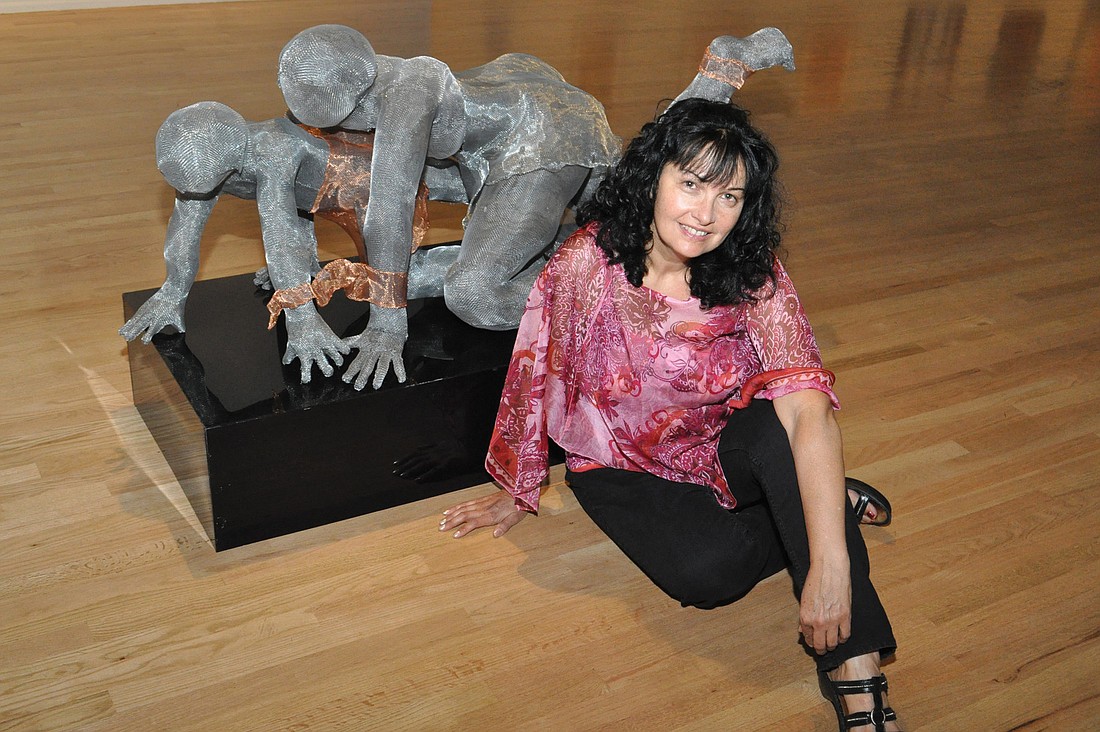- October 19, 2022
-
-
Loading

Loading

Two transparent, faceless bodies perch on all fours. The larger female body cradles the smaller under her life-like muscular body. One leg is extended, slightly reaching behind. The figures are three-dimensional and so life-like, it would not be surprising to learn models posed while the artist delicately molded every part of them, including fingers and toes, with a sheet of wire mesh.
Bradenton resident Ofra Freidman’s sculpture is stationary but exudes movement. It is abstract, but, in a way, based on reality. Her other sculptures follow suit; each shape carrying a particular flow, each of her works evoking a particular feeling. And, as with most art, the emotion conjured is dependent on the viewer’s take.
The piece described is called “Time Fraction,” and it is currently featured in Ringling College of Art and Design’s Selby Gallery, as part of the Florida Artist Group juried exhibition that runs through June 1.
And although “Time Fraction” could be representative of Freidman’s daughter, Noa, recently married and moving away from home. But Friedman says the context isn’t important.
“I usually don’t like to feed the viewer with what a piece means,” says Friedman. “What led me to create is not as important to me as the feeling that the piece gives you.”
Friedman has been dabbling in mixed-media and making wire-mesh sculptures for the past 10 years. She made her first sculpture at age 18. It was a self-portrait of clay that led her to take her first art class during which she made her second sculpture. The second sculpture depicted a pair of detailed hands — her career epiphany.
“I felt that (art) was something that I’ve always done. It was almost like discovering an ability that I had (all along),” she says.
In response to that sculpture, her teacher invited her to study in Paris. Freidman decided not to, and it turned out to be a wise decision.
“If I took that step, it would have changed my life … I wouldn’t have met my husband,” says Friedman. She met her husband, Aharon, while performing Israeli folk dances.
After the completion of his graduate studies, her physicist husband moved them to Canada, and, then, to the U.S., where they have lived for the past 27 years. Freidman continued her studies all over the country, in everything from interior design to Afro-American dance. But she was always the most attracted to 3-D art.
Friedman’s real love was sculpture, and she found herself working with stone, casting and mixed-media. It was on a trip to Israel that she met a wire-mesh artist named Shulamit Hartal. Friedman took a few workshops from the artist and discovered her passion for wire-mesh.
“She developed her own technique that is different from any artist I have seen in the U.S., and I was inspired by her,” says Friedman of Hartal.
Upon returning to the U.S., Friedman formed her own style. Since then, she has received all types of honors for her artistic method; most recently, she won first place at the Winthrop Arts Festival in Riverview.
Friedman still has creative ties to her home country — she buys large rolls of inexpensive, flexible wire mesh from Israel because she cannot find it in the U.S.
“I always get questions at the airport and always have some problems,” she laughs.
Her creations start as a 3-by-3-foot piece of mesh on which she sketches. She pulls it into different shapes and directions using ceramic tools and her imagination. Surprisingly, she has never used a human model, but, occasionally, she studies human anatomy to ensure the hands and feet are just right. It makes sense, because it was a sculpture of hands that made her realize art was inside her — part of her core.
Freidman creates the majority of her work indoors, at her home in Bradenton. Her mornings are spent doing administration: planning for exhibitions, contests and even the curation of shows. She sculpts in the evening.
“I usually work until about 2 a.m. I’m very much a night owl,” she says.
Because her work is big, 10 feet tall in one case (ironic, considering Friedman’s petite frame), some of it is fragmented in separate mesh pieces stemming from plexiglass. Some pieces are mixed-media and involve welding. Others are collaborations with other artists. But, for the most part, the subjects of her work remain consistent: large-scale metal trees and human figures. They have a natural feel reminiscent of their creator.
Her works are featured in Sarasota and beyond; at a chiropractor’s home in Clearwater and as far north as North Carolina, where she has three pieces on display at Polk State College. The piece featured in Selby Gallery is unique in that she typically prefers to exhibit her work outdoors.
“I’m very attracted to outdoor sculpture because I want to improve (and enhance) the environment through my art,” she says.